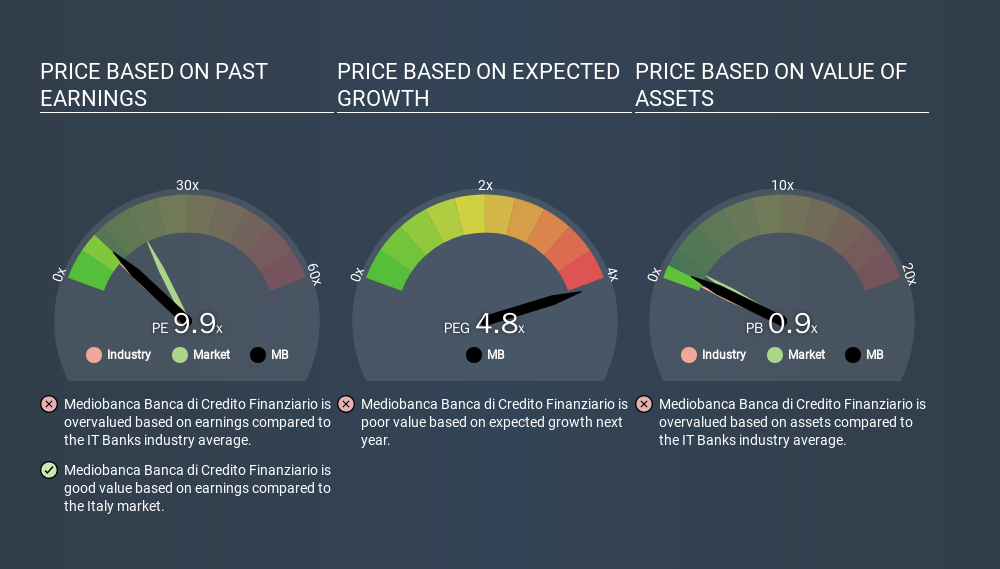Don't Sell Mediobanca Banca di Credito Finanziario S.p.A. (BIT:MB) Before You Read This

This article is written for those who want to get better at using price to earnings ratios (P/E ratios). We'll show how you can use Mediobanca Banca di Credito Finanziario S.p.A.'s (BIT:MB) P/E ratio to inform your assessment of the investment opportunity. Mediobanca Banca di Credito Finanziario has a P/E ratio of 9.86, based on the last twelve months. In other words, at today's prices, investors are paying €9.86 for every €1 in prior year profit.
Check out our latest analysis for Mediobanca Banca di Credito Finanziario
How Do I Calculate A Price To Earnings Ratio?
The formula for P/E is:
Price to Earnings Ratio = Price per Share ÷ Earnings per Share (EPS)
Or for Mediobanca Banca di Credito Finanziario:
P/E of 9.86 = EUR9.59 ÷ EUR0.97 (Based on the trailing twelve months to September 2019.)
Is A High Price-to-Earnings Ratio Good?
The higher the P/E ratio, the higher the price tag of a business, relative to its trailing earnings. That isn't a good or a bad thing on its own, but a high P/E means that buyers have a higher opinion of the business's prospects, relative to stocks with a lower P/E.
How Does Mediobanca Banca di Credito Finanziario's P/E Ratio Compare To Its Peers?
One good way to get a quick read on what market participants expect of a company is to look at its P/E ratio. As you can see below, Mediobanca Banca di Credito Finanziario has a higher P/E than the average company (8.7) in the banks industry.

Its relatively high P/E ratio indicates that Mediobanca Banca di Credito Finanziario shareholders think it will perform better than other companies in its industry classification. Clearly the market expects growth, but it isn't guaranteed. So further research is always essential. I often monitor director buying and selling.
How Growth Rates Impact P/E Ratios
P/E ratios primarily reflect market expectations around earnings growth rates. When earnings grow, the 'E' increases, over time. And in that case, the P/E ratio itself will drop rather quickly. Then, a lower P/E should attract more buyers, pushing the share price up.
Mediobanca Banca di Credito Finanziario saw earnings per share improve by -3.6% last year. And it has bolstered its earnings per share by 13% per year over the last five years.
A Limitation: P/E Ratios Ignore Debt and Cash In The Bank
One drawback of using a P/E ratio is that it considers market capitalization, but not the balance sheet. So it won't reflect the advantage of cash, or disadvantage of debt. Hypothetically, a company could reduce its future P/E ratio by spending its cash (or taking on debt) to achieve higher earnings.
Such expenditure might be good or bad, in the long term, but the point here is that the balance sheet is not reflected by this ratio.
So What Does Mediobanca Banca di Credito Finanziario's Balance Sheet Tell Us?
Mediobanca Banca di Credito Finanziario has net debt worth a very significant 214% of its market capitalization. This level of debt justifies a relatively low P/E, so remain cognizant of the debt, if you're comparing it to other stocks.
The Bottom Line On Mediobanca Banca di Credito Finanziario's P/E Ratio
Mediobanca Banca di Credito Finanziario has a P/E of 9.9. That's below the average in the IT market, which is 18.8. The meaningful debt load is probably contributing to low expectations, even though it has improved earnings recently.
Investors should be looking to buy stocks that the market is wrong about. If the reality for a company is not as bad as the P/E ratio indicates, then the share price should increase as the market realizes this. So this free visualization of the analyst consensus on future earnings could help you make the right decision about whether to buy, sell, or hold.
But note: Mediobanca Banca di Credito Finanziario may not be the best stock to buy. So take a peek at this free list of interesting companies with strong recent earnings growth (and a P/E ratio below 20).
If you spot an error that warrants correction, please contact the editor at editorial-team@simplywallst.com. This article by Simply Wall St is general in nature. It does not constitute a recommendation to buy or sell any stock, and does not take account of your objectives, or your financial situation. Simply Wall St has no position in the stocks mentioned.
We aim to bring you long-term focused research analysis driven by fundamental data. Note that our analysis may not factor in the latest price-sensitive company announcements or qualitative material. Thank you for reading.
About BIT:MB
Mediobanca Banca di Credito Finanziario
Provides various banking products and services in Italy and internationally.
Established dividend payer with proven track record.
Similar Companies
Market Insights
Community Narratives




